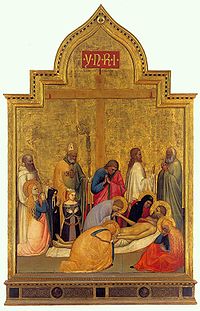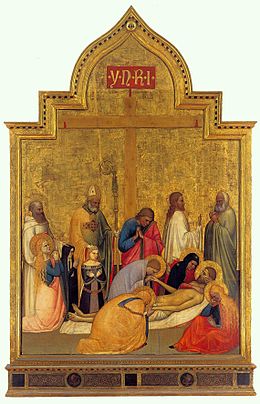Giacobbe Giusti, GIOTTINO: Pietà of San Remigio, Galleria degli Uffizi, Florence

Giottino (* zwischen 1320 und 1330, laut Vasari 1324 in Florenz; † nach 1369 ebenda) war ein italienischer Maler aus Florenz. Sein richtiger Name lautete Tommaso (kurz: Maso) di Stefano.
Giottinos Vater war selbst ein berühmter Maler, der seinen Sohn dazu anleitete, die Arbeiten vom großen Giotto zu studieren, um von ihnen zu lernen. Da er seinen Stil an den von Giottos Werken anlehnte, wurde Maso als Giottino(d. h. kleiner Giotto) oder als Giotto di Stefanooder Giotto di Maestro Stefano bekannt.
Die Fresken des Heiligen Silvester in der Kirche Santa Croce (Florenz) sind ihm zugeschrieben, sie zeigen die Legende von Papst Silvester I.Auch Fresken in der Kirche San Remigio in Florenz sowie ein Freskenzyklus in der Unterkirche der Basilika San Francesco in Assisi stammen womöglich von ihm.
Eine große Anzahl weiterer Werke werden ihm zugeschrieben, auch z. B. eine Marmorstatue, die auf dem Campanile des Domes in Florenz steht.
| Naissance | |
|---|---|
| Décès | |
| Autres noms |
Giotto di Stefano
Tommaso Fiorentino Maso di Stefano |
| Nationalité | |
| Activité |
Peintre
|
|
Pietà de San Remigio
|
Giottino (fl. 1324 – 1369), also known as Tommaso Fiorentino, was an early Italianpainter from Florence. His real name was Maso di Stefano or Tommaso di Stefano.
Giottino’s father, Maestro Stefano Fiorentino, “Stefano the Foorentine”, was himself a celebrated painter in the school of Giotto; his naturalism earned him the appellation “Scimmia della Natura”, the “Ape of Nature” for his perceived realism. He instructed his son, who applied himself to studying the works of the great Giotto. Since he formed his style on Giotto’s works, Maso became known as Giottino. the “little Giotto”.
The frescoes in the chapel of San Silvestro in the Florentine Basilica of Santa Croce are attributed to Giottino; these represent the miracles of Pope St Sylvester as narrated in the Golden Legend.
A large number of other works have been attributed to Giottino including Apparition of the Virgin to St Bernard and a marble statue erected on the Florentine campanile.
Giorgio Vasari, the chronicler of the Italian Renaissance, includes a biography of Giottino in the second part of his famous Lives of the Most Excellent Painters, Sculptors, and Architects (Le Vite de’ più eccellenti pittori, scultori, e architettori da Cimabue insino a’ tempi nostri).
Giotto di Stefano ou Tommaso (ouMaso) di Stefano ou Tommaso Fiorentino1, connu sous le nom de Giottino, (Florence avant 1324 – Florence après 1369) est un peintre italien qui fut actif au xive siècle2.
Biographie
Peintre de la Renaissancefréquemment identifié comme le fils de Giotto1. C’est probablement plus celui de Stefano Fiorentino, disciple de Giotto. Si sa vie est mentionnée par Vasari, ses œuvres restent rares.
Son chef-d’œuvre incontesté reste sa Pietà (musée des Offices) où il excelle dans la représentation des sentiments. Il fait également preuve d’un réalisme développé qui témoigne des tendances de la Florence de son époque.
Son activité est aujourd’hui encore au centre de problèmes compliqués d’identification et d’attribution. Par exemple, le Portrait de Jean II le Bon lui est parfois attribué, sans que l’on puisse s’en assurer absolument. Il a été confondu pendant des siècles avec Maso di Banco et avec Stefano Fiorentino lui-même3.
Œuvres
- Pietà de San Remigio (vers 1365), tempera sur bois, 195 cm × 134 cm, Galerie des Offices, Florence.
- Jugement dernier, Ajaccio.
- Descente de Croix, musée des Offices, Florence.
- Légende de saint Sylvestre, Basilique Santa Croce de Florence.
- Vie du Christ, Basilique Santa Maria Novella, Florence.
- Annonciation, Pise.
- Portrait de Jean II le Bon, Paris.
- Un triptyque, Montauban.
- Fresques, Assise.


